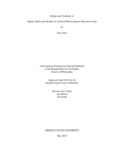Design and Synthesis of Organic Molecular Models of Artificial Photosynthetic Reaction Center
Abstract
A clean and sustainable alternative to fossil fuels is solar energy. For efficient use
of solar energy to be realized, artificial systems that can effectively capture and convert
sunlight into a usable form of energy have to be developed. In natural photosynthesis,
antenna chlorophylls and carotenoids capture sunlight and transfer the resulting excitation
energy to the photosynthetic reaction center (PRC). Small reorganization energy, λ and
well-balanced electronic coupling between donors and acceptors in the PRC favor
formation of a highly efficient charge-separated (CS) state.
By covalently linking electron/energy donors to acceptors, organic molecular
dyads and triads that mimic natural photosynthesis were synthesized and studied.
Peripherally linked free base phthalocyanine (Pc)-fullerene (C60) and a zinc (Zn)
phthalocyanine-C60 dyads were synthesized. Photoexcitation of the Pc moiety resulted in
singlet-singlet energy transfer to the attached C60, followed by electron transfer. The
lifetime of the CS state was 94 ps. Linking C60 axially to silicon (Si) Pc, a lifetime of the
CS state of 4.5 ns was realized. The exceptionally long-lived CS state of the SiPc-C60
dyad qualifies it for applications in solar energy conversion devices. A secondary
electron donor was linked to the dyad to obtain a carotenoid (Car)-SiPc-C60 triad and
ferrocene (Fc)-SiPc-C60 triad. Excitation of the SiPc moiety resulted in fast electron
transfer from the Car or Fc secondary electron donors to the C60. The lifetime of the CS
state was 17 ps and 1.2 ps in Car-SiPc-C60 and Fc-SiPc-C60, respectively.
ii
In Chapter 3, an efficient synthetic route that yielded regioselective oxidative
porphyrin dimerization is presented. Using Cu2+ as the oxidant, meso-β doubly-connected
fused porphyrin dimers were obtained in very high yields. Removal of the copper from
the macrocycle affords a free base porphyrin dimer. This allows for exchange of metals
and provides a route to a wider range of metallporphyrin dimers.
In Chapter 4, the development of an efficient and an expedient route to
bacteriopurpurin synthesis is discussed. Meso-10,20- diformylation of porphyrin was
achieved and one-pot porphyrin diacrylate synthesis and cyclization to afford
bacteriopurpurin was realized. The bacteriopurpurin had a reduction potential of – 0.85 V
vs SCE and λmax, 845 nm.

